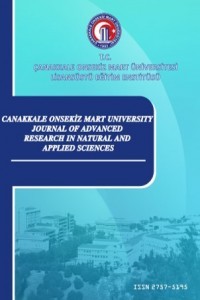Kanatlı İşletmelerinden Kaynaklanan Koku Probleminin Belirlenmesinde Bir E-Burun Sisteminin Kullanılması
Hayvansal üretimin çevreye olan etkileri arasında gübre kaynaklı koku, özellikle kanatlı işletmelerinde karşımıza büyük bir problem olarak çıkmaktadır. Gübre işletim sistemlerinin tasarımında ve yönetiminde dikkate alınması gereken koku probleminin başlıca kaynağı hayvan gübresinden yayılan gazlar, uçucu organik bileşikler ve diğer bazı unsurlardır. Dolayısıyla, bu probleme neden olan unsurlar koku probleminin dışında barınak içerisindeki hayvanların ve çalışan işçilerin sağlıkları üzerinde de olumsuz etkilere sahip olmaktadır. Koku son derece sübjektif bir kavram olduğundan ölçülmesi ve şiddetinin belirlenmesi oldukça güçtür. Son yıllarda elektronik alanındaki gelişmelere bağlı olarak insan burnunu taklit ederek çalışan elektronik burun sistemleri (EBS) de bu amaçla kullanılmaktadır.Bu çalışmada, elektronik burun sistemi ile hava kalitesi ölçüm ve uyarı cihazları eş zamanlı kullanılarak, her iki sistemin performansı karşılaştırılmıştır.Seçilen bir kanatlı işletmesinin çevresinden alınan hava örnekleri, her iki cihazla da okunarak elde edilen değerler, coğrafi bilgi sistemi kullanılarak noktalanmış ve kokunun dağılımı yüzey istatistiği yöntemiyle modellenmiştir.
Anahtar Kelimeler:
elektronik burun, gaz sensörü, hava kalitesi, koku, kümes
Use of an E-Nose System in the Determination of Odor Problem Generated from Poultry Operations
Among the environmental impacts of livestock production, especially poultry operations, manure related odor problems appear to be highly important. Major source of odor that should be considered in the design and management of manure management systems are gases, volatile organic compounds and some other particles. Hence, those sources that causes odor and health problems for housed livestock and workers. It is highly difficult to identify and measure the level of odor since it is a subjective term. Electronic nose systems (ENS) that mimic human olfaction have been widely used in this area depending on the recent advances in electronics. The aim of this study is to compare the performance of an electronic nose system with an air quality sensing module by using these both systems simultaneously.Air quality samples were collected from a poultry house’s surroundings. Each sample was subjected to both systems simultaneously. Those readings were applied to Geographical Information Systems to spatially model the odor dispersion using geostatistics.
Keywords:
air quality, e-nose, gas sensor, odour, poultry housin,
___
- Barisci J., Andrew M., Harris P., Patridge A., Wallace, G., 1997. Development of an Electronic Nose. Proc. of Smart Electric Nose, Spie, 3242: 164-171.
- Bras R. L., Rodriguez-Iturbe I., 1985. Random Functions and Hydrology. Reading Mass. Addison Wesley. 359-425.
- Brattoli M., de Gennaro G., de Pinto V., Loiotile A. D., Lovascio S., Penza M., 2011. Odour Detection Methods: Olfactometry and Chemical Sensors, Sensors, 11: 5290-5322.
- Davis M. W., Culhane P.G., 1984. Contouring Very Large Data Sets Using Kriging; Geostatistics for Natural Resources Characterization, Part 2. Dordrecht. The Netherlands. Reidel. 599-619.
- GD 780, 2006. Government Decision Regarding the Establish¬ment of Emissions Trading in Greenhouse Gas Emissions, As Amended by GD 133 . Issue: 554
- Görgülü M., Darcan N., Göncü S., 2009. Hayvancılık ve Küresel Isınma. V. Ulusal Hayvan Besleme Kongresi (Uluslararası Katılımlı). Çorlu, 30 Eylül-3 Ekim 2009.
- Hosseini E., Gallichand J., Caron J., 1993. Comparison of Several Interpolators for Smoothing Hydraulic Conductivity Data in South West Iran. American Society of Agricultural Engineers. 36(6): 1687-1693.
- Panigrahi S., Kizil U., Balasubramanian S., Doetkott C., Logue C., Marchello M., Gu H., Kubiak A., Nolan L., Schneider J., Wiens R., 2002. Electronic Nose System For Meat Quality Evaluation. 2002 ASAE/CIGR Annual International Meeting, Makale No., 026094, Chicago, Illinois, USA.
- Vac S.C., Popita G.E., Frunzeti N., Popovici A., 2013. Evaluation of Greenhouse Gas Emission from Animal Manure Using the Closed Chamber Method for Gas Fluxes. Not Bot Horti Agrobo, 41(2):576-581.
- Wathes C. M., Holden M. R., Sneath R. W., White R.P., and Phillips V. R., 1997. Concentrations and Emission Rates of Aerial Ammonia, Nitrous Oxide, Methane, Carbon Dioxide, Dust and Eendotoxin in UK Broiler and Layer Houses. British Poultry Science, 38: 14 – 28.
- Yayın Aralığı: Yılda 4 Sayı
- Başlangıç: 2015
- Yayıncı: Çanakkale Onsekiz Mart Üniversitesi
Sayıdaki Diğer Makaleler
Cahit Çağlar YALÇINER, Erdem GÜNDOĞDU, Yunus Can KURBAN, Erhan ALTUNEL
Simav Fayındaki Düşey Yerdeğiştirmelerin, GPR (Yeraltı Radarı) Yöntemi ile Belirlenmesi
Erdem GÜNDOĞDU, Yunus Can KURBAN, Cahit Çağlar YALÇINER, Süha ÖZDEN
Güzin AK GÖKSU, Canan ÖZTOKAT KUZUCU
Üç Noktalı Eğilme Altındaki Betonarme Kirişlerde Karbon Lifli Polimerin Etkin ve Ekonomik Kullanımı
H. Orhun KÖKSAL, Ferruh ALTINSOY, Selen AKTAN, Şebnem KARAHAN, Rahman ÇANKAYA
